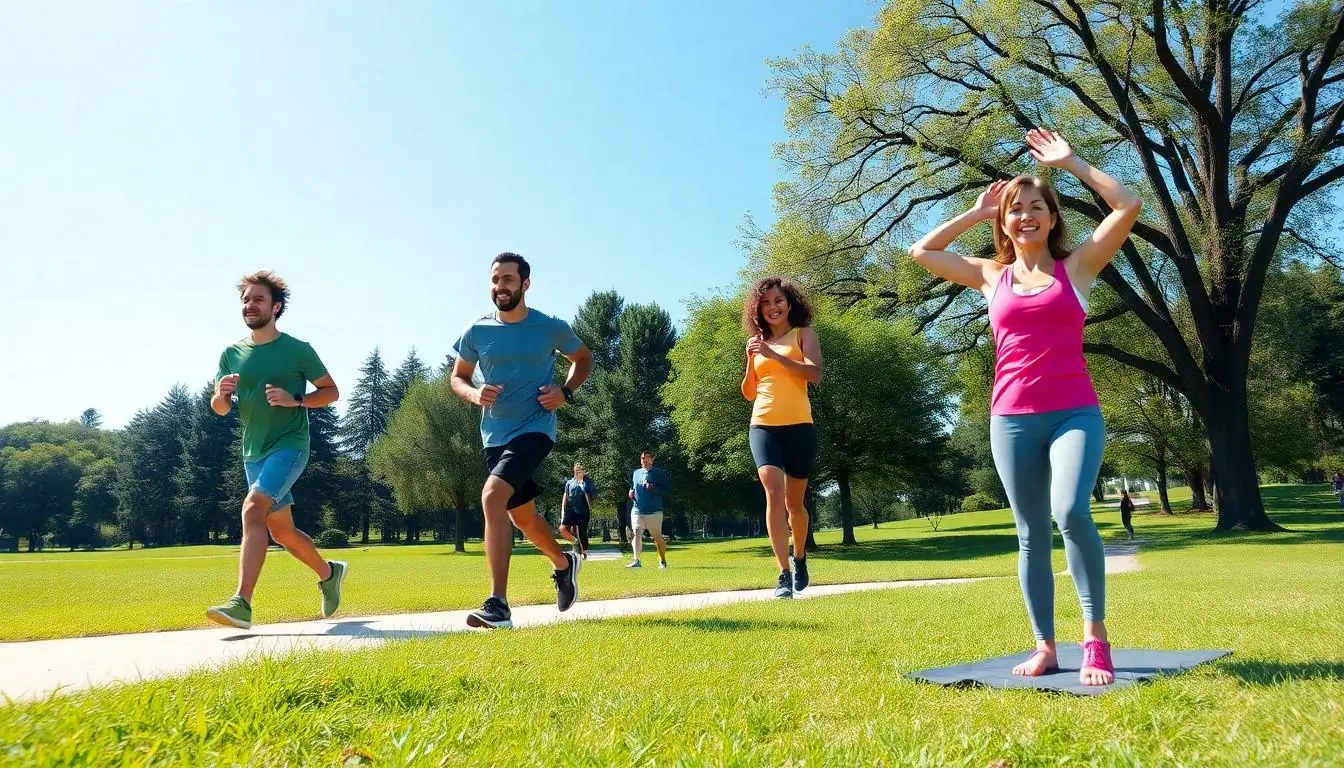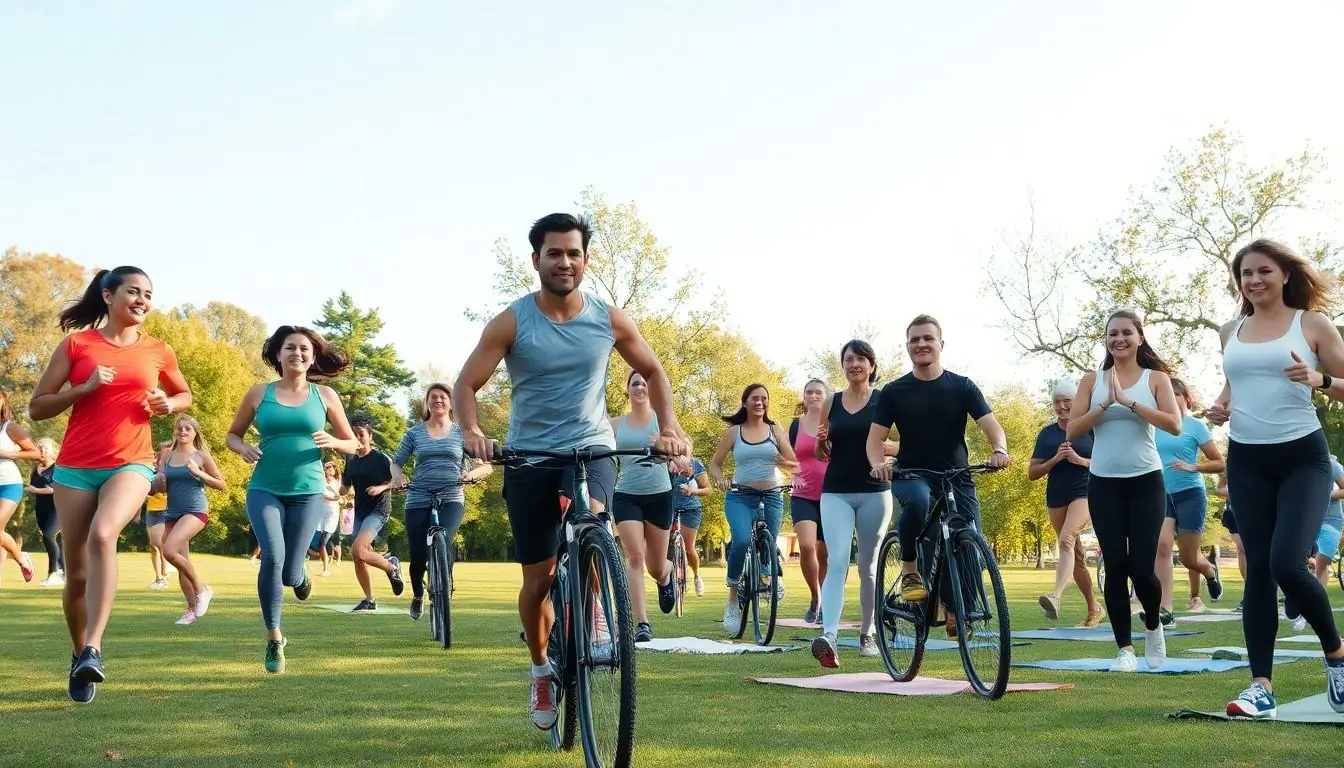When it comes to staying fit, the options can feel overwhelming. From yoga that stretches your body and mind to high-intensity workouts that make you question your life choices, the world of physical activity is vast. But not all activities are created equal. Some might even leave you scratching your head, wondering if they truly count as exercise.
In this article, we’ll explore the physical activities that boost health and well-being while playfully calling out the oddball activities that don’t quite make the cut. So grab your workout gear—though you might not need it for this read—and get ready to discover what’s truly beneficial for your body. Who knew learning about fitness could be this fun?
Table of Contents
ToggleOverview of Beneficial Physical Activities
Beneficial physical activities encompass a variety of exercises that contribute to overall health. Engaging in activities like walking, running, cycling, and swimming significantly enhances cardiovascular fitness. Strength training, including weight lifting and resistance exercises, improves muscle strength and bone density.
Moreover, flexibility exercises, such as yoga and Pilates, play a crucial role in maintaining joint health and preventing injuries. They enhance balance and coordination, which is essential for everyday activities. Group sports like basketball and soccer offer not only physical benefits but also social interaction and teamwork skills.
Dancing serves as another enjoyable way to stay active. It combines physical movement with rhythm, facilitating both aerobic fitness and emotional expression. Furthermore, outdoor activities like hiking and kayaking expose individuals to nature, which has additional mental health benefits.
While many activities provide unique advantages, some options may not fit the criteria for beneficial exercise. Passive activities, such as watching television or sitting for long periods, contribute little to physical health. Recognizing the significance of incorporating diverse exercise types aids in creating a well-rounded fitness routine.
Emphasizing the importance of regular movement supports long-term health. Combining various activities can maximize benefits and keep routines engaging. Pursuing enjoyable options increases adherence and fosters a lifelong commitment to staying active.
Common Types of Physical Activities

Physical activities encompass various forms of exercise that significantly impact health. Engaging in diverse workouts not only strengthens the body but also promotes mental well-being.
Aerobic Exercises
Aerobic exercises enhance cardiovascular health through sustained activities that elevate heart rates. Walking, jogging, cycling, and swimming are popular examples that improve endurance and stamina. Participants often experience increased energy levels and better mood regulation as a result of consistent aerobic activity. Studies indicate that 150 minutes of moderate-intensity aerobic exercise each week greatly reduces the risk of heart disease and other chronic conditions.
Strength Training
Strength training focuses on building muscle mass and increasing overall strength. Resistance exercises, such as weightlifting and bodyweight workouts, significantly contribute to muscle development. Engaging in two or more sessions per week helps maintain muscle mass while improving metabolic rate. Research shows that this form of exercise boosts bone density and enhances functional fitness, aiding daily activities.
Flexibility and Balance Exercises
Flexibility and balance exercises are crucial for maintaining overall mobility and stability. Activities like yoga and Pilates improve flexibility while promoting core strength. Participants notice enhanced posture and reduced risk of injuries with regular practice. Balance training, such as tai chi or simple standing exercises, supports functional movement, particularly in older adults. These exercises contribute to a well-rounded fitness routine, ensuring long-term physical health.
Misunderstood Activities
Physical activities vary significantly in their impact on health, with some commonly misunderstood behaviors included in this discussion.
Sedentary Behaviors
Sedentary behaviors refer to activities that involve little to no physical movement. Watching television, sitting at a desk, or playing video games are classic examples. Although these pastimes provide relaxation, they don’t contribute to physical fitness. Research shows prolonged sedentary time increases the risk of chronic conditions like obesity and heart disease. It’s crucial to balance time spent in sedentary activities with more dynamic options. Engaging in short walks or stretching breaks can alleviate the negative effects of excessive sitting.
Non-structured Activities
Non-structured activities encompass informal opportunities for movement that often go unrecognized as exercise. Gardening, walking the dog, or playing tag with children fit this definition. While these may not follow a typical workout regimen, they promote physical activity and improve overall wellness. They encourage movement without the pressure of formal exercise, making them more approachable for many. Incorporating non-structured activities into daily routines enhances physical health while fostering enjoyment in movement and reducing stress levels.
Importance of Regular Exercise
Regular exercise plays a crucial role in health and well-being. It significantly enhances cardiovascular fitness and boosts endurance, which are essential for overall physical performance. Engaging in activities like walking, running, or cycling leads to improved heart health and a reduced risk of chronic diseases.
Strength training offers additional benefits. Building muscle mass increases metabolic rates and promotes strength, which is important for maintaining a healthy body composition. Activities that target flexibility, like yoga and Pilates, contribute to improved mobility and injury prevention, especially in older adults.
Integrating group sports provides social interaction alongside physical benefits. Team sports such as basketball and soccer promote not only fitness but also teamwork and community engagement. These social elements boost motivation to stay active in a fun environment.
Enjoyable activities also play a role in well-being. Dancing, hiking, and kayaking offer not just a workout but also mental health advantages through connection with nature, creativity, and pleasure. Engaging in these pleasurable experiences helps sustain long-term commitment to fitness.
Balancing active pursuits with sedentary behaviors is key. Limiting time spent on passive activities like watching TV is vital for overall health. Incorporating small bouts of movement throughout daily routines can significantly enhance physical fitness and decrease stress levels.
Fostering a variety of exercise types encourages lifelong fitness habits. A mix of aerobic, strength, and flexibility exercises provides comprehensive benefits that support both physical and mental health. Embracing this diversity ensures a richer, more satisfying fitness experience.
Staying active is essential for maintaining health and well-being. Engaging in a variety of physical activities not only boosts cardiovascular fitness but also enhances strength and flexibility. By incorporating enjoyable exercises into daily routines, individuals can cultivate a sustainable fitness lifestyle.
It’s crucial to recognize which activities truly contribute to physical health and to balance them with less active pursuits. Embracing movement in diverse forms ensures a richer experience and promotes mental clarity. Ultimately, prioritizing enjoyable and effective exercises paves the way for long-term fitness success.



